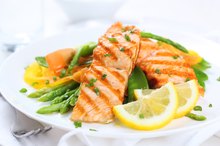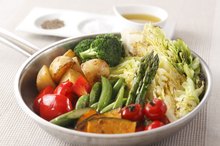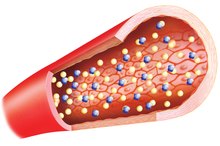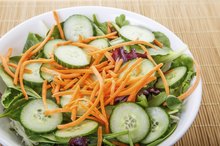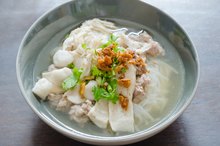Although there is no specific cardiac stent diet, people who have had a cardiac stent and been diagnosed with heart disease should focus on a diet that is low in animal fat and high in polyunsaturated and monounsaturated fats. Dietary considerations after having a cardiac stent include consuming foods that can prevent blockages in the arteries. The goal is to lower LDL cholesterol levels, raise good HDL cholesterol and keep weight under control.
Low-Calorie Food
A heart-healthy diet includes low-calorie food. Obesity can lead to diabetes and high blood pressure, which boosts the chances of coronary artery disease. Keeping track of calories is an important component of a heart-healthy diet. Consuming more calories than are burned daily can thwart efforts at maintaining normal body mass index. Consult your physician or a nutritionist for help determining your daily caloric needs, based on activity level.
- A heart-healthy diet includes low-calorie food.
- Consuming more calories than are burned daily can thwart efforts at maintaining normal body mass index.
Focus on Nutrients
Foods for Stroke Patients
Learn More
Types of foods to focus on after having a cardiac stent include a variety of colorful fruits and vegetables rich in vitamins and minerals. Fiber and nutrients in plant-based foods help control blood pressure and weight gain. Unrefined grains found in bulgur wheat, oatmeal, brown rice, whole wheat and popcorn help control cholesterol levels. Salmon, trout and herring are high in omega-3 fatty acids and linked to decreased risk of dying from heart disease. Legumes, nuts, avocados and olives are heart-healthy sources of monounsaturated fat.
- Types of foods to focus on after having a cardiac stent include a variety of colorful fruits and vegetables rich in vitamins and minerals.
- Salmon, trout and herring are high in omega-3 fatty acids and linked to decreased risk of dying from heart disease.
Dietary Salt
To control blood pressure and maintain cardiovascular health and blood flow, limit salt intake to 2,400 mg per day. Season foods with herbs, pepper and lemon and avoid boxed and prepackaged foods that are high in sodium. Choose low-sodium soups and broths.
Cholesterol and Saturated Fats
Quadruple Bypass & Diet
Learn More
The National Heart, Blood and Lung Institute recommends consuming no more than 300 mg of cholesterol daily. Reading food labels helps determine how much cholesterol is in a serving portion. Saturated fat in the diet can lead to weight gain, increase cholesterol levels and contribute to atherosclerosis. Sources of fat to avoid after a cardiac stent include beef, pork, bacon, butter and luncheon meats. Saturated fat also is found in poultry skin and dairy products like cream, cheese and butter. The American Heart Association recommends consuming no more than 7 percent of calories daily from saturated fat 123.
- The National Heart, Blood and Lung Institute recommends consuming no more than 300 mg of cholesterol daily.
Limit Trans Fats
Trans fats come from fried foods, baked goods, cookies, pizza dough and stick margarine, and are known to raise levels of LDL cholesterol. They are added to foods to improve texture and taste and extend shelf life. Trans fats on food labels also might be described as “partially hydrogenated oils.” The American Heart Association states that just 1 percent of daily calories should come from trans fats 123.
Heart Heathy Oils
Substitute heart-healthy oils in place of butter and shortening. Flaxseed, olive, toasted sesame and wheat germ oils can be used for dressings and marinades. Light olive oil, canola and peanut oils can be used for searing and browning because of their high smoke point. Soybean oil can be used in sauces for sauteed foods and low-heat baking. Canola oil can be used in place of butter and margarine in recipes and has a high smoke point, making it versatile for cooking.
- Substitute heart-healthy oils in place of butter and shortening.
- Light olive oil, canola and peanut oils can be used for searing and browning because of their high smoke point.
Related Articles
References
- American Heart Association: Diet and Lifestyle
- American Heart Association: Saturated Fats
- American Heart Association: Trans Fats
- American Heart Association: Added Sugars Add to Your Risk of Dying from Heart Disease.
- National Cholesterol Education Panel. Third report of the National Cholesterol Education Program (NCEP) Expert Panel on Detection, Evaluation, and Treatment of High Blood Cholesterol in Adults (Adult Treatment Panel III) final report. Circulation 2002;106:3143–3421.
- Whitney EN and SR Rolfes. Understanding Nutrition, 14ed. Wadsworth Publishing 2015.
Writer Bio
Kathleen Blanchard is a registered nurse, with more than 10 years of experience in cardiovascular health, emergency room and ICU. She writes professionally for Emaxhealth.com. and AskMen.com. Blanchard is currently employed as a senior case manager and has held certification as a critical care registered nurse (CCRN), advanced trauma life support (ATLS), and advanced cardiac life support (ACLS).
